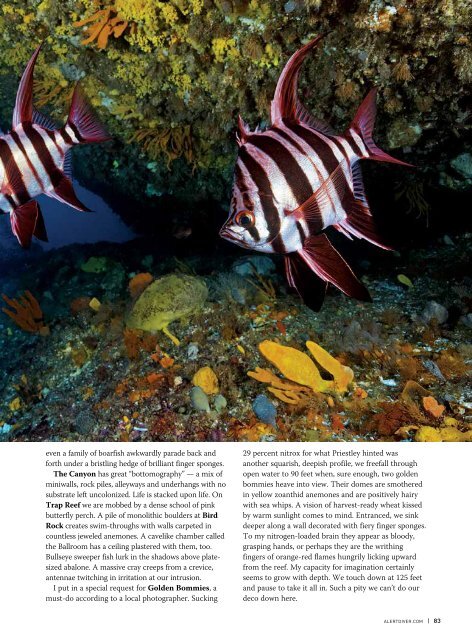AD 2015 Q4
This is the “not do” component. It is also somewhat harder to define. After all, who determines the duty to care and the non-compliance thereto in unique emergency situations? Still, this component is more likely to lead to a recovery of damages. Put differently, when you are under a legal duty to take reasonable care and you do not do it, then you could be held liable for damages that are directly caused by the breach of that duty. The key elements are “reasonable care” and “directly caused”. Let’s break that down, starting with directly caused. This means that the damages are linked directly to the failure to perform the reasonable duty. This is called a causal connection. In other words, there must be a connection between the duty not complied with and the damages. deep diving are so hazardous that it may well be better to only jeopardise the life of one individual rather than two. That is, of course, as long as no one is put at risk during the subsequent body recovery or rescue efforts! Well, as a qualified instructor and dive leader, I shall continue to teach and advocate the buddy system. I do not like the idea of diving alone anyway. I prefer to share the joys of diving with someone able to share the memories of the dive. To me, diving is, and remains, a team sport. Which introduces another consideration: How would the principle of duty to take care be applied to children who dive? Training agencies impose age and depth restrictions on children who enter the sport before the age of 14. Depending on the age and diving course, a child may be required to dive with an instructor or at least another adult dive buddy. If the adult were to get into trouble, the child would not be expected to meet the duty of care of another adult. He/she would be held to an age appropriate standard. What about all those waivers? As mentioned in the previous article, waivers define the boundaries of the self-imposed risk divers are willing to take by requiring that they acknowledge them. Waivers do not remove all the potential claims for negligence and non-compliance with a duty of care. As such, it is left to our courts to ultimately interpret the content of a waiver within the actual context of damage or injury.
This is the “not do” component. It is also somewhat harder to define. After all, who determines the duty to care and the non-compliance thereto in unique emergency situations? Still, this component is more likely to lead to a recovery of damages. Put differently, when you are under a legal duty to take reasonable care and you do not do it, then you could be held liable for damages that are directly caused by the breach of that duty. The key elements are “reasonable care” and “directly caused”. Let’s break that down, starting with directly caused. This means that the damages are linked directly to the failure to perform the reasonable duty. This is called a causal connection. In other words, there must be a connection between the duty not complied with and the damages.
deep diving are so hazardous that it may well be better to only jeopardise the life of one individual rather than two. That is, of course, as long as no one is put at risk during the subsequent body recovery or rescue efforts! Well, as a qualified instructor and dive leader, I shall continue to teach and advocate the buddy system. I do not like the idea of diving alone anyway. I prefer to share the joys of diving with someone able to share the memories of the dive. To me, diving is, and remains, a team sport. Which introduces another consideration: How would the principle of duty to take care be applied to children who dive? Training agencies impose age and depth restrictions on children who enter the sport before the age of 14. Depending on the age and diving course, a child may be required to dive with an instructor or at least another adult dive buddy. If the adult were to get into trouble, the child would not be expected to meet the duty of care of another adult. He/she would be held to an age appropriate standard. What about all those waivers? As mentioned in the previous article, waivers define the boundaries of the self-imposed risk divers are willing to take by requiring that they acknowledge them. Waivers do not remove all the potential claims for negligence and non-compliance with a duty of care. As such, it is left to our courts to ultimately interpret the content of a waiver within the actual context of damage or injury.
You also want an ePaper? Increase the reach of your titles
YUMPU automatically turns print PDFs into web optimized ePapers that Google loves.
even a family of boarfish awkwardly parade back and<br />
forth under a bristling hedge of brilliant finger sponges.<br />
The Canyon has great “bottomography” — a mix of<br />
miniwalls, rock piles, alleyways and underhangs with no<br />
substrate left uncolonized. Life is stacked upon life. On<br />
Trap Reef we are mobbed by a dense school of pink<br />
butterfly perch. A pile of monolithic boulders at Bird<br />
Rock creates swim-throughs with walls carpeted in<br />
countless jeweled anemones. A cavelike chamber called<br />
the Ballroom has a ceiling plastered with them, too.<br />
Bullseye sweeper fish lurk in the shadows above platesized<br />
abalone. A massive cray creeps from a crevice,<br />
antennae twitching in irritation at our intrusion.<br />
I put in a special request for Golden Bommies, a<br />
must-do according to a local photographer. Sucking<br />
29 percent nitrox for what Priestley hinted was<br />
another squarish, deepish profile, we freefall through<br />
open water to 90 feet when, sure enough, two golden<br />
bommies heave into view. Their domes are smothered<br />
in yellow zoanthid anemones and are positively hairy<br />
with sea whips. A vision of harvest-ready wheat kissed<br />
by warm sunlight comes to mind. Entranced, we sink<br />
deeper along a wall decorated with fiery finger sponges.<br />
To my nitrogen-loaded brain they appear as bloody,<br />
grasping hands, or perhaps they are the writhing<br />
fingers of orange-red flames hungrily licking upward<br />
from the reef. My capacity for imagination certainly<br />
seems to grow with depth. We touch down at 125 feet<br />
and pause to take it all in. Such a pity we can’t do our<br />
deco down here.<br />
ALERTDIVER.COM | 83









